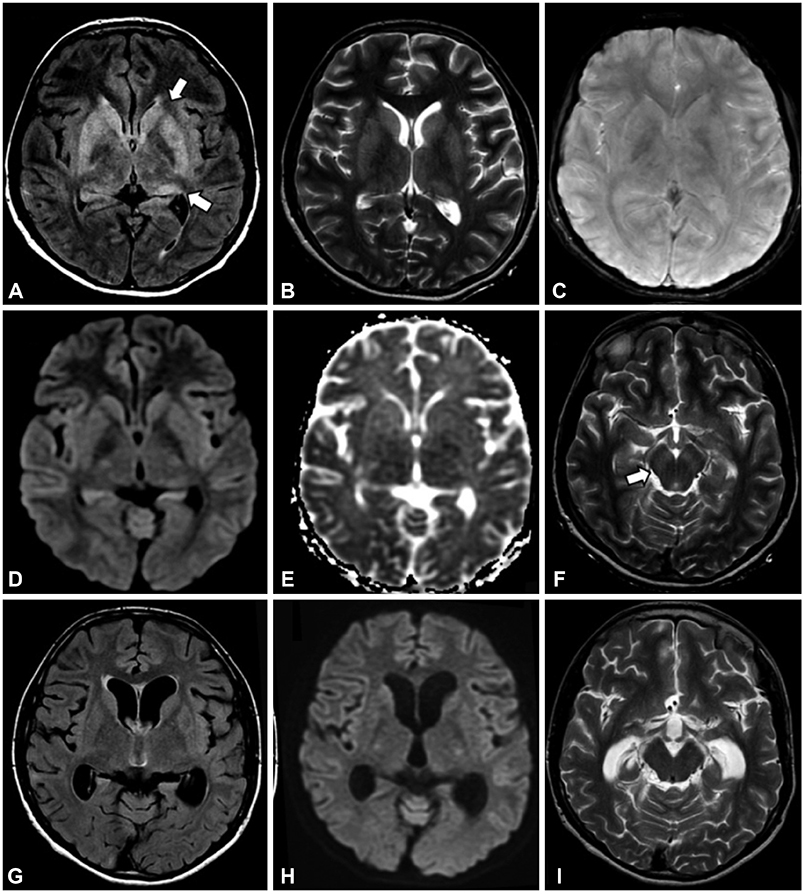J Clin Neurol.
2019 Jul;15(3):424-426. 10.3988/jcn.2019.15.3.424.
Secondary Movement Disorder in a Case of Diphtheric Encephalitis: Clinical and Neuroimaging Features of a Rare Association
- Affiliations
-
- 1Department of Diagnostic and Interventional Neuroradiology, Institute of Neurosciences, Apollo Speciality Hospital, Jayanagar, Bangalore, India.
- 2Division of Movement Disorders, Department of Neurology, Institute of Neurosciences, Apollo Speciality Hospital, Jayanagar, Bangalore, India. sanjivchamraj@gmail.com
- 3Department of Otorhinolaryngology, Apollo Speciality Hospital, Jayanagar, Bangalore, India.
- 4Department of Paediatric Pulmonology, Institute of Pulmonology, Apollo Speciality Hospital, Jayanagar, Bangalore, India.
- KMID: 2451136
- DOI: http://doi.org/10.3988/jcn.2019.15.3.424
Abstract
- No abstract available.
Figure
Reference
-
1. Murhekar M. Epidemiology of diphtheria in India, 1996–2016: implications for prevention and control. Am J Trop Med Hyg. 2017; 97:313–318.
Article2. Jayashree M, Shruthi N, Singhi S. Predictors of outcome in patients with diphtheria receiving intensive care. Indian Pediatr. 2006; 43:155–160.3. Jhunjhunwala K, Netravathi M, Pal PK. Movement disorders of probable infectious origin. Ann Indian Acad Neurol. 2014; 17:292–297.
Article4. Das B, Chakravarthi S, Goyal MK, Modi M, Vyas S, Lal V, et al. Postencephalitic parkinsonism: interesting clinico-imaging correlation. J Neurol Sci. 2014; 343:215–217.
Article5. Mikulowski V. Encephalitis in diphtheria. Arch Fr Pediatr. 1956; 13:293–298.6. Laha PN. Diphtheritic encephalomyelitis. Indian J Pediatr. 1954; 21:26–27.
Article7. Hall WE. Diphtheria and acute toxic encephalitis, with the report of a case. Can Med Assoc J. 1932; 26:566–569.8. Foo JC, Rahmat K, Mumin NA, Koh MT, Gan CS, Ramli N, et al. Diphtheric encephalitis and brain neuroimaging features. J Clin Neurosci. 2017; 45:155–157.
Article9. Dolgopol VB, Katz SH. Encephalitis in diphtheria. Am J Dis Child. 1950; 79:640–657.
Article10. Martino D, Giovannoni G. Antibasal ganglia antibodies and their relevance to movement disorders. Curr Opin Neurol. 2004; 17:425–432.
Article11. Rebai I, Ben Rhouma H, Kraoua I, Klaa H, Rouissi A, Ben Youssef-Turki I, et al. Postencephalitic parkinsonism and selective involvement of substantia nigra in childhood. Brain Dev. 2015; 37:153–157.
Article


